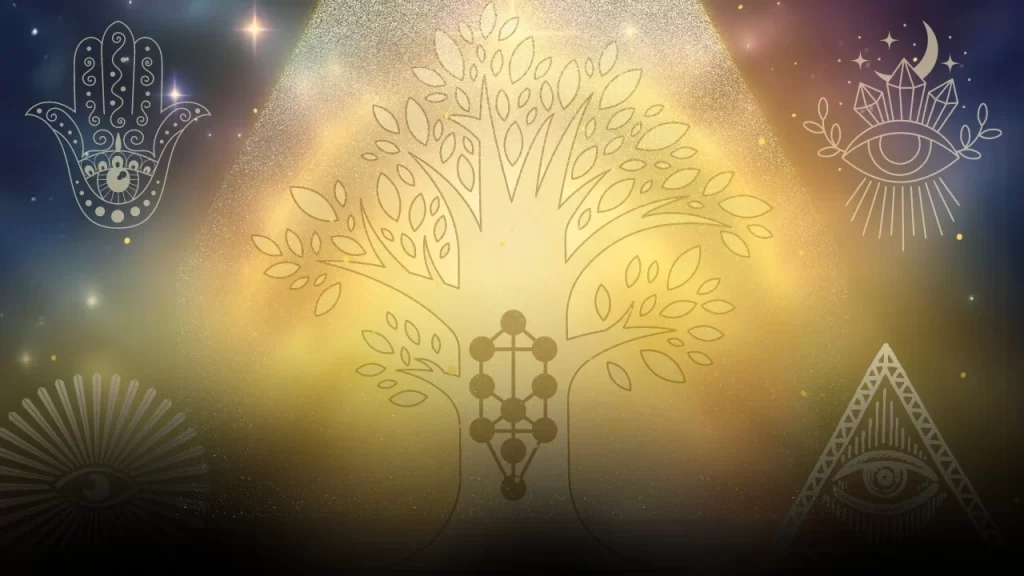Manage your energy with Kabbalah
The Tree of Life is one of the most important symbols in Kabbalah, representing a metaphysical structure that describes the flow of divine energy and the process of creation. It is composed of ten spheres, called sefirot, which are interconnected by 22 paths, forming a diagram that serves as a spiritual roadmap.
The Sefirot and Their Meanings:
Each sefirá (singular of sefirot) represents an aspect of divine emanation and qualities that can also be developed within the human being. They are organized into three main pillars:
1. Pillar of Mercy (right) – Represents qualities like kindness and expansion.
2. Pillar of Severity (left) – Represents restraint, judgment, and strength.
3. Pillar of Balance (center) – Represents harmony and the integration of the other two pillars.
The sefirot, from top to bottom, are:
1. Keter (Crown) – The highest sphere, representing divine will and the origin of all things. It is the connection to the infinite.
2. Chochmah (Wisdom) – Pure inspiration or the seed of creation.
3. Binah (Understanding) – The development of the idea, symbolizing mental gestation and structure.
4. Chesed (Kindness) – Unconditional love, mercy, and generosity.
5. Gevurah (Severity) – Discipline, judgment, and strength.
6. Tiferet (Beauty) – Harmony and balance between kindness and severity, symbolizing compassion.
7. Netzach (Eternity) – Perseverance, endurance, and determination.
8. Hod (Glory) – Humility, submission, and reverence.
9. Yesod (Foundation) – The foundation that connects the spiritual and physical worlds, representing creativity and bonding.
10. Malchut (Kingdom) – The lowest sphere, representing the physical world and the final manifestation of divine energy.
The Paths:
The 22 paths connecting the sefirot correspond to the letters of the Hebrew alphabet and symbolize processes of transformation and spiritual ascent. These paths metaphorically represent the interactions between the different divine attributes.

Symbolism:
• The Tree of Life reflects the cycle of creation and the manifestation of the divine in the universe.
• It also serves as a map for human spiritual development, representing the soul’s journey toward unity with the Divine Source.
• Each sefirá is associated with parts of the body, elements of nature, and psychological aspects.
Ultimately, the Tree of Life is not just a theoretical concept but also a practical tool used in Kabbalah for meditation, self-awareness, and understanding the human role within the cosmos.
Kabbalah provides individuals with a framework to understand and manage their energy by aligning their spiritual, emotional, and physical aspects with the flow of divine energy in the universe. This is achieved through its teachings on the sefirot (the ten spheres of the Tree of Life), which represent different dimensions of energy and consciousness. Each sefirá embodies a specific quality, such as wisdom, compassion, or discipline, and understanding these qualities helps individuals balance and channel their energy effectively.
Key Ways Kabbalah Helps Manage Energy:
1. Self-Awareness Through the Sefirot:
• Each sefirá corresponds to an aspect of a person’s inner life. For example:
• Chesed (Kindness) teaches how to expand energy through love and generosity.
• Gevurah (Discipline) emphasizes setting boundaries and conserving energy.
• Tiferet (Harmony) helps balance emotional and mental energy.
• By meditating on or reflecting on these sefirot, individuals can identify imbalances in their energy and work toward realignment.
2. Balancing Giving and Receiving:
• Kabbalah emphasizes the importance of balancing the flow of energy between giving and receiving. It teaches that excessive giving without boundaries (Chesed) can lead to burnout, while over-restriction (Gevurah) can cause stagnation. Learning to harmonize these forces helps individuals manage their energy sustainably.
3. Connecting to the Divine Source:
• Through practices like prayer, meditation, and the study of sacred texts, Kabbalah encourages individuals to connect with the infinite divine energy. This connection replenishes their inner energy and helps them align their actions with a higher purpose.
4. Overcoming Reactive Patterns:
• Kabbalah teaches that negative emotions and reactive behaviors drain energy. By cultivating mindfulness and self-discipline, individuals can transform reactive patterns into proactive, conscious choices, preserving their energy for meaningful actions.
5. Practical Tools for Energy Management:
• Meditation on the Names of God: Kabbalistic meditation focuses on divine names and symbols that are believed to channel spiritual energy, helping individuals recharge and refocus.
• Observing Cycles: Kabbalah recognizes the natural cycles of energy (e.g., the lunar calendar) and encourages living in harmony with these rhythms to optimize energy use.
6. Aligning with Purpose:
• Kabbalah emphasizes that energy is most efficiently used when aligned with one’s higher purpose or mission in life. By understanding their unique role in creation, individuals can focus their energy on actions that bring fulfillment and spiritual growth.
In summary, Kabbalah helps individuals manage their energy by fostering self-awareness, promoting balance, and providing tools for spiritual connection and transformation. By aligning with the principles of the Tree of Life, one can use their energy more intentionally and harmoniously, creating a more meaningful and empowered life.


